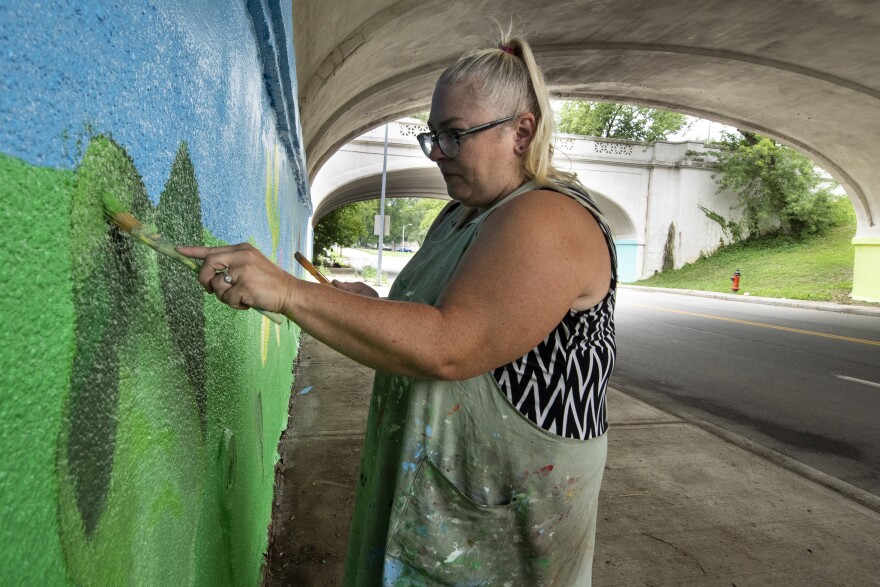Eastern Tiger Swallowtail and Monarch butterflies flutter through a field of native plants on a mural taking shape on 77th Street, just beneath the Paseo bridge in south Kansas City.
Artist Julie Farstad is busy adding green details to a heart-shaped redbud leaf she’s painting. She's spent many humid, summer days working on a series of murals featuring Missouri’s native plants and insects.
The bridge's concrete foundations don't make the job easy, Farstad says. The walls are rough and they soak in a lot of paint.
“There's a few areas where it's super bumpy and it's really weird to paint on,” she says.
Farstad is a professor of painting at the Kansas City Art Institute. She lives nearby in the Marlborough neighborhood, stretching south from 77th Street to 85th Street, and east from Troost Avenue to Prospect Avenue.
“Marlborough is a really great neighborhood, active neighbors, people who help each other, kids who play together,” Farstad says.
But in early 2020, boarded-up homes and run-down buildings were so common here, the city designated nearly 350 acres as a blighted area.
“On one hand, that's good for us because they give us some sort of tax incentive — and that's great,” Farstad says. “But also, it's very stressful, and it feels bad to live in a blighted place. So I thought, you know, wouldn't it be amazing if this neighborhood was just full of butterflies?”
Farstad calls her ongoing project “Flowers for Marlborough.” It started with Farstad growing butterfly milkweed, Indian blanket, and other plants from seed, then having plant giveaways in her front yard. Later, the boarded-up windows of abandoned homes in the neighborhood became canvases for her paintings of native flowers. She also holds pop-up painting sessions for local kids.
But this mural is Farstad’s most ambitious project yet.
“The cool part of it is just dealing with a scale like this,” Farstad says. “You have to be able to just trust your ability to make it work out, and I kind of like that risk, you know? It's like walking a tightrope.”
With the help of several former KCAI painting students, Farstad has spent much of her summer break designing and painting four 63-foot panels beneath the bridge.
"This is the biggest painting that I've ever done, for sure," Farstad says.

To take on a project of this scale, Farstad partnered with the Missouri Prairie Foundation. For more than 50 years, the foundation has worked to conserve the state's native grasslands.
The Missouri prairie is a delicate ecosystem that evolved over thousands of years. But today very little undisturbed grasslands remain. The foundation's executive director, Carol Davit, says artists like Farstad help expand their mission.
"Julie is creating these murals to be part of the cityscape, and for people to enjoy,” Davit says. “Not only does it add beauty, but it's bringing a part of Missouri's natural heritage to people in a new way.”
Sharing her skills
For Farstad, slowing down to observe the natural world is part of the artistic process, and "it's through drawing and painting plants that I got into native plants,” she says.
Farstad also enjoys finding ways to share her skills with others. In June, she held a series of pop-up painting events at Marlborough Elementary School. At one workshop, she brought purple coneflower for families to paint.
“Do you want to know something interesting about this flower?” Farstad asked attendees, holding up a blossom with a spiny orange center and bright purple petals. “It's called Echinacea purpurea, and native bumblebees love these, hummingbirds love these, goldfinches love to eat the seeds.”

Through work like this, Farstad wants to transform the way people see beauty in their yards, and encourage them to restore the plants that once grew here.
“One of the things that I love so much is just watching all of the butterflies in my backyard, and all the bees, and watching their behavior and feeling happy that they are getting to eat something that you planted for them,” Farstad says.
But native plants aren’t just beautiful — they’re survivors, and they’ve evolved to thrive in Missouri's climate. Even in urban areas, plants like these are important because they help prevent flooding, Farstad says, because their long roots soak up storm water runoff and keep it out of the sewers. That’s something grass lawns just don’t do.
“The lower Midwest and elsewhere are using native plants to great advantage, and successfully, to help manage stormwater,” Davit says, "but you can't start until you have a familiarity with those plants. So what Julie is doing is really important.”
Davit says even small patches of native plants help support a wide variety of songbirds, insects and other wildlife. To help people access these plants, the Missouri Prairie Foundation sponsors regular native plant sales at The Anita B. Gorman Conservation Discovery Center in Kansas City.
And once those native plants take root, Farstad says, suburban backyards spring to life.
“If we could teach people that it's beautiful to live with different sized plants, it's beautiful to see them relating to one another,” Farstad says. “It's beautiful to see dragonflies and butterflies and native bees interacting.”

While there's still a lot of painting left to do on the mural, Farstad says she's leaving one section open intentionally, so other people in the neighborhood can paint a few flowers of their own.






